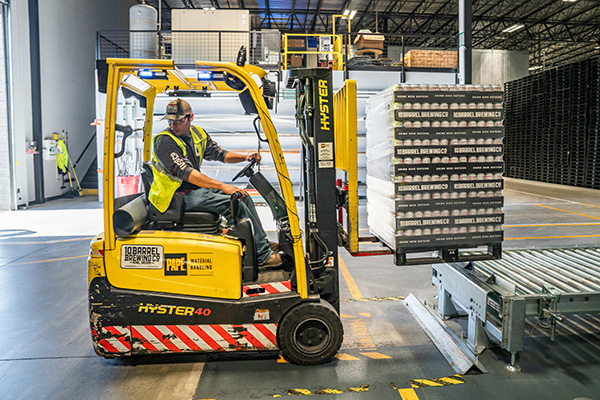Manufacturers can brace for tariff-related disruptions by building smart warehouses with AIoT solutions.
By Scott Walker, VP of Supply Chain Product Management at Powerfleet
Global supply chains face unprecedented challenges as the Trump administration has significantly escalated trade policies by imposing and then temporarily pausing extensive reciprocal tariffs on imports from nearly every country worldwide. Should tariffs go back into effect, U.S. manufacturers reliant on imported components could pay significantly more, often 20–30% higher, for essential raw materials, forcing some to pass expenses onto consumers or seek alternative suppliers. These disruptions underscore the importance of agility and adaptability in today’s global market, as companies must navigate not only shifting trade policies but also the ripple effects on pricing, lead times, and customer expectations.
While policy changes are out of our control, we do have power over how we adapt and brace for disruption. Supply chain leaders across the U.S. are reassessing strategies in response to potential tariff implementations – for example, nearshoring or reshoring operations. While there are many benefits to nearshoring or reshoring, these strategies are not always possible for every organization, and they can’t be done overnight. It can be expensive to pick up and move manufacturing facilities, not to mention other considerations to keep in mind, like the availability of necessary resources or the risk of transporting goods across regions with less stable infrastructure.
Beyond nearshoring, many manufacturers also need to improve the efficiency and safety of their end-to-end operations to save costs and remain vigilant. During this period of rapid policy shifts, it’s more essential than ever to have access to tools and technology that enable continuous monitoring and control, and one way to do this is through Artificial Intelligence of Things (AIoT).
The intersection of Artificial Intelligence (AI) and the Internet of Things (IoT) has given rise to a novel technological frontier: the Artificial Intelligence of Things (AIoT).
AIoT combines IoT devices’ data-gathering capabilities with AI’s analytical power. In a warehouse, IoT sensors collect real-time data on everything from equipment performance to inventory levels and environmental conditions. AI algorithms then analyze this data to identify patterns, predict issues, and automate decision-making. The result is a smarter, more responsive warehouse that can adapt quickly to changing demands and external pressures like tariffs.
While some rising shipping costs due to tariffs cannot be controlled, expenses can be reduced in other areas by improving efficiency. Also, by using AI-powered data and insights, we can make proactive decisions and quickly adapt when tariff-related supply chain disruptions occur.
AIoT doesn’t just improve what happens inside the warehouse – it also enhances visibility across the entire supply chain. IoT devices track shipments in transit, while AI analyzes transportation data to identify bottlenecks and suggest alternative routes. This end-to-end transparency allows manufacturers to anticipate tariff-related disruptions and adjust their logistics strategies accordingly.
This kind of comprehensive visibility enables precise monitoring, ensuring smooth operations amid global uncertainty.
AIoT provides actionable insight to help leaders make better decisions through:
There are also challenges to consider when integrating AIoT, including data security, infrastructure investment, and skills gaps. Workforce training is essential to ensure all systems operate effectively. However, when implemented correctly, this integrated approach removes operational blind spots between facilities and transportation routes, maintaining consistently high standards throughout the supply chain even during disruptive times.

Every few days, someone in the US gets seriously injured from an accident involving material handling equipment, sometimes fatally. In fact, forklifts alone cause an average of 85 deaths per year. Modern warehouses are under immense pressure to deliver faster and operate more efficiently – an effect that will be even more exacerbated if and when tariffs go into effect to attempt to keep costs down. This pressure to meet KPIs and control costs may otherwise lead to workplace injuries.
Innovative technology using AI provides a path forward that does not sacrifice safety for productivity. Rather than using reactive approaches, AIoT solutions predict and prevent risky situations through continuous monitoring to create a protective environment across all asset types. AIoT data can promote better safety in warehouses through:
It is possible to maintain efficiency while safeguarding people and assets. It just requires some assistance from AI and automation tools to identify risks in real time. Too many facilities still depend on manual processes or disconnected safety tools. We must shift as an industry to proactive risk management as opposed to reactive, especially when it comes to protecting our people at a time when so much is up in limbo.
Organizations focusing on improving efficiency and safety through unified operational intelligence can reduce costs and set themselves up for success should tariff policies change. As global trade dynamics evolve, manufacturing warehouses must be agile and resilient. For companies facing tariff uncertainty, the question is not whether to adopt AIoT but how quickly they can do so to remain resilient, competitive, and cost-effective.
Ultimately, efficient warehouses minimize costs, keep employees safer, and maximize customer satisfaction through improved operations. This approach positions them to be prepared to handle any current situations and future disruptions, regardless of how global trade looks in the weeks, months, or years to come.
For more information on how AIoT can help your supply chain, visit https://www.powerfleet.com/.

About the Author:
Scott Walker serves as Vice President of Supply Chain Product Management for Powerfleet, leading Powerfleet’s supply chain product teams to drive innovative products and solutions. Walker has over 25 years of experience leading product strategy, technological innovation, and product development execution. For the last 18 years, Scott has led various roles within Powerfleet’s product, implementation, and sales teams. Prior to joining Powerfleet, Walker held various leadership positions at Emerson Electric as part of the Industrial Automation group. He attended the University of Rhode Island, holding a BS in Chemical Engineering.
Read more from the author:
Tackling Labor Shortages in Warehouses & Manufacturing, September 14, 2023
How Technology is Advancing Industrial Safety, July 7, 2023
In this episode, I sat down with Beejan Giga, Director | Partner and Caleb Emerson, Senior Results Manager at Carpedia International. We discussed the insights behind their recent Industry Today article, “Thinking Three Moves Ahead” and together we explored how manufacturers can plan more strategically, align with their suppliers, and build the operational discipline needed to support intentional, sustainable growth. It was a conversation packed with practical perspectives on navigating a fast-changing industry landscape.